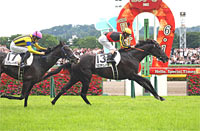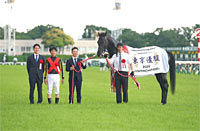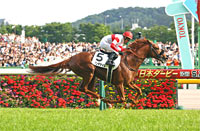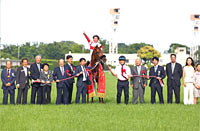Tokyo Yushun (Japanese Derby) (G1) - Data Analysis
Race that bestows the highest honor
A derby triumph is the dream of every runner, and this year’s Tokyo Yushun (Japanese Derby) will again be contested by the best 3-year-olds following a rigorous qualifying process. In the past 10 years, eight runners backed as 1st favorite finished in the Top 3, four of which secured a victory. At the same time, however, nine runners backed as 6th favorite or lower also finished in the Top 3, so we should not overlook the fact that poorly rated runners have often delivered strong performances. As we approach this pulsating fixture, let’s analyze some features shared by successful runners in this race from results over the last 10 years.
Top win ratios for runners backed as 3rd-5th favorite in previous race
Looking at runners over the last 10 years in terms of favoritism in their previous race, we find that runners that had been backed as “3rd-5th favorite” enjoyed Win ratios in excess of 10%. The Top 2 ratio exceeded 10% for runners that had been backed as “1st-5th favorite,” but dropped below 3% for runners that had been backed as “6th-9th favorite” or “10th favorite or lower.” The Top 3 ratio was over 20% for runners that had been backed as “1st-5th favorite,” but below 8% for runners that had been backed as “6th or lower,” revealing a wide gap between the groups. [Table 1]
[Table 1] Performance by favoritism in previous race (last 10 years)
Favoritism in
previous race |
Performance
[1st-2nd-3rd-4th or lower] |
Win ratio |
Top 2 ratio |
Top 3 ratio |
| 1st favorite |
3-2-4-22 |
9.7% |
16.1% |
29.0% |
| 2nd favorite |
0-6-0-18 |
0% |
25.0% |
25.0% |
| 3rd favorite |
3-0-3-14 |
15.0% |
15.0% |
30.0% |
| 4th favorite |
2-1-0-12 |
13.3% |
20.0% |
20.0% |
| 5th favorite |
1-0-1-6 |
12.5% |
12.5% |
25.0% |
| 6th-9th favorite |
0-1-2-35 |
0% |
2.6% |
7.9% |
| 10th favorite or lower |
1-0-0-41 |
2.4% |
2.4% |
2.4% |
Check last-but-one race
Looking at runners over the last 10 years in terms of their last-but-one race, the bulk of the runners in the Top 3 had entered a turf graded race over a distance of 1,800m to 2,000m, such as the Hochi Hai Yayoi Sho (Japanese 2000 Guineas Trial) or the Fuji TV Sho Spring Stakes (Japanese 2000 Guineas Trial), as their last-but-one race. Excluding 2017 winner Rey de Oro, which had contested its last-but-one race in the Hopeful Stakes, from this group, we find that runners that had contested their last-but-one race in the Kyodo News Hai (Tokinominoru Kinen) enjoyed notably high Top 2 and Top 3 ratios. However, among runners that entered a graded turf race over a distance of 1,800m to 2,000m as their last-but-one race, those that contested the Satsuki Sho (Japanese 2000 Guineas) struggled. In addition, runners that ran in an Open-class stakes or an Allowance-class race as their last-but-one race also fared poorly. It may be interesting to check the last-but-one race contested by the runners. [Table 2]
[Table 2] Performance by last-but-one race (last 10 years)
| Last-but-one race |
Performance
[1st-2nd-3rd-4th or lower] |
Win ratio |
Top 2 ratio |
Top 3 ratio |
Hochi Hai Yayoi Sho
(Japanese 2000 Guineas Trial) |
3-3-2-25 |
9.1% |
18.2% |
24.2% |
Fuji TV Sho Spring Stakes
(Japanese 2000 Guineas Trial) |
2-2-1-21 |
7.7% |
15.4% |
19.2% |
| Mainichi Hai |
2-0-1-13 |
12.5% |
12.5% |
18.8% |
Kyodo News Hai
(Tokinominoru Kinen) |
1-2-1-6 |
10.0% |
30.0% |
40.0% |
| Keisei Hai |
1-0-0-5 |
16.7% |
16.7% |
16.7% |
| Hopeful Stakes |
1-0-0-0 |
100% |
100% |
100% |
| Kisaragi Sho (NHK Sho) |
0-2-0-6 |
0% |
25.0% |
25.0% |
| 1-win class race |
0-1-3-22 |
0% |
3.8% |
15.4% |
Satsuki Sho
(Japanese 2000 Guineas) |
0-0-2-14 |
0% |
0% |
12.5% |
| Other races |
0-0-0-36 |
0% |
0% |
0% |
Strong performance in graded turf 2,000m+ race is key
Looking at runners over the last 10 years in terms of their highest finish in a graded turf 2,000m+ race, we find that eight of the 10 winners had experience of winning a graded turf 2,000m+ race. Runners with such experience also enjoyed an excellent Top 3 ratio of over 40%. Among Top 2 finishers, 17 of 20 runners had finished “1st-4th” in a graded turf 2,000m+ race. Meanwhile, runners with no experience of entering a graded turf 2,000m+ race produced only one Top 3 finisher, namely 2008 winner Deep Sky. In other words, runners that have risen to the top in a graded turf 2,000m+ race should be rated highly. [Table 3]
[Table 3] Performance by highest finish in a graded turf 2,000m+ race (last 10 years)
| Highest finish |
Performance
[1st-2nd-3rd-4th or lower] |
Win ratio |
Top 2 ratio |
Top 3 ratio |
| 1st |
8-5-5-26 |
18.2% |
29.5% |
40.9% |
| 2nd |
0-1-2-36 |
0% |
2.6% |
7.7% |
| 3rd |
1-1-0-12 |
7.1% |
14.3% |
14.3% |
| 4th |
0-1-0-6 |
0% |
14.3% |
14.3% |
| 5th |
0-0-0-7 |
0% |
0% |
0% |
| 6th-9th |
0-2-2-20 |
0% |
8.3% |
16.7% |
| 10th or lower |
0-0-1-16 |
0% |
0% |
5.9% |
Not entered in graded turf
2,000m+ race |
1-0-0-25 |
3.8% |
3.8% |
3.8% |
Watch time difference with runner-up in Open-class turf races in which runners were victorious
Looking at runners over the last 10 years in terms of the highest time difference with a runner-up in an open-class turf race in which the runners were victorious, we find the highest time difference was “0.1s or less” for 64 runners, and “0.2s-0.5s” or “0.6s or above” for 69 runners, reflecting a roughly even distribution. However, 17 of the 20 Top 2 finishers belonged to the “0.2s-0.5s” or “0.6s or above” group, and success ratios for this group were also distinctly better. In other words, our attention should be on runners that have experience of winning an open-class turf race with a substantial lead over the runner-up. [Table 4]
[Table 4] Performance by highest time difference with runner-up in Open-class turf race in which runners were victorious (last 10 years)
| Highest time difference |
Performance
[1st-2nd-3rd-4th or lower] |
Win ratio |
Top 2 ratio |
Top 3 ratio |
| 0.1s or less |
1-2-3-58 |
1.6% |
4.7% |
9.4% |
| 0.2s-0.5s |
8-6-5-40 |
13.6% |
23.7% |
32.2% |
| 0.6s or higher |
1-2-0-7 |
10.0% |
30.0% |
30.0% |
No victory in
Open-class turf race |
0-0-2-43 |
0% |
0% |
4.4% |
Seek out the winner!
Check favoritism and finish in last-but-one race
The nine winners since 2009 were all backed as 4th favorite or higher in their last-but-one race, and finished that race in the Top 2. If we confine our analysis to performance by finish, we note that runners that finished in the Top 2 of their last-but-one race have consistently produced winners in this race for the last 15 years, starting with 2003 winner Neo Universe. [Table 5]
[Table 5] Winners’ favoritism and finish in last-but-one race (last nine years)
| Year |
Winner |
Favoritism and finish in last-but-one race |
| 2009 |
Logi Universe |
1st favorite |
1st |
| 2010 |
Eishin Flash |
1st favorite |
1st |
| 2011 |
Orfevre |
1st favorite |
1st |
| 2012 |
Deep Brillante |
1st favorite |
2nd |
| 2013 |
Kizuna |
1st favorite |
1st |
| 2014 |
One and Only |
4th favorite |
2nd |
| 2015 |
Duramente |
1st favorite |
2nd |
| 2016 |
Makahiki |
2nd favorite |
1st |
| 2017 |
Rey de Oro |
1st favorite |
1st |
(Michio Kawano)
|

- Preview
- Barrier draw
- Past performances of runners

- News
- Race result
- Video
- 2025 English

- 2024 English

- 2023 English

- 2022 English

- 2021 English

- 2020 English

- 2019 English

- 2018 English

- 2017 English

- 2016 English

- 2015 English

- 2014 English

- 2013 English

- Photo Gallery
2025 Winner: Croix du Nord


2024 Winner: Danon Decile


|



















